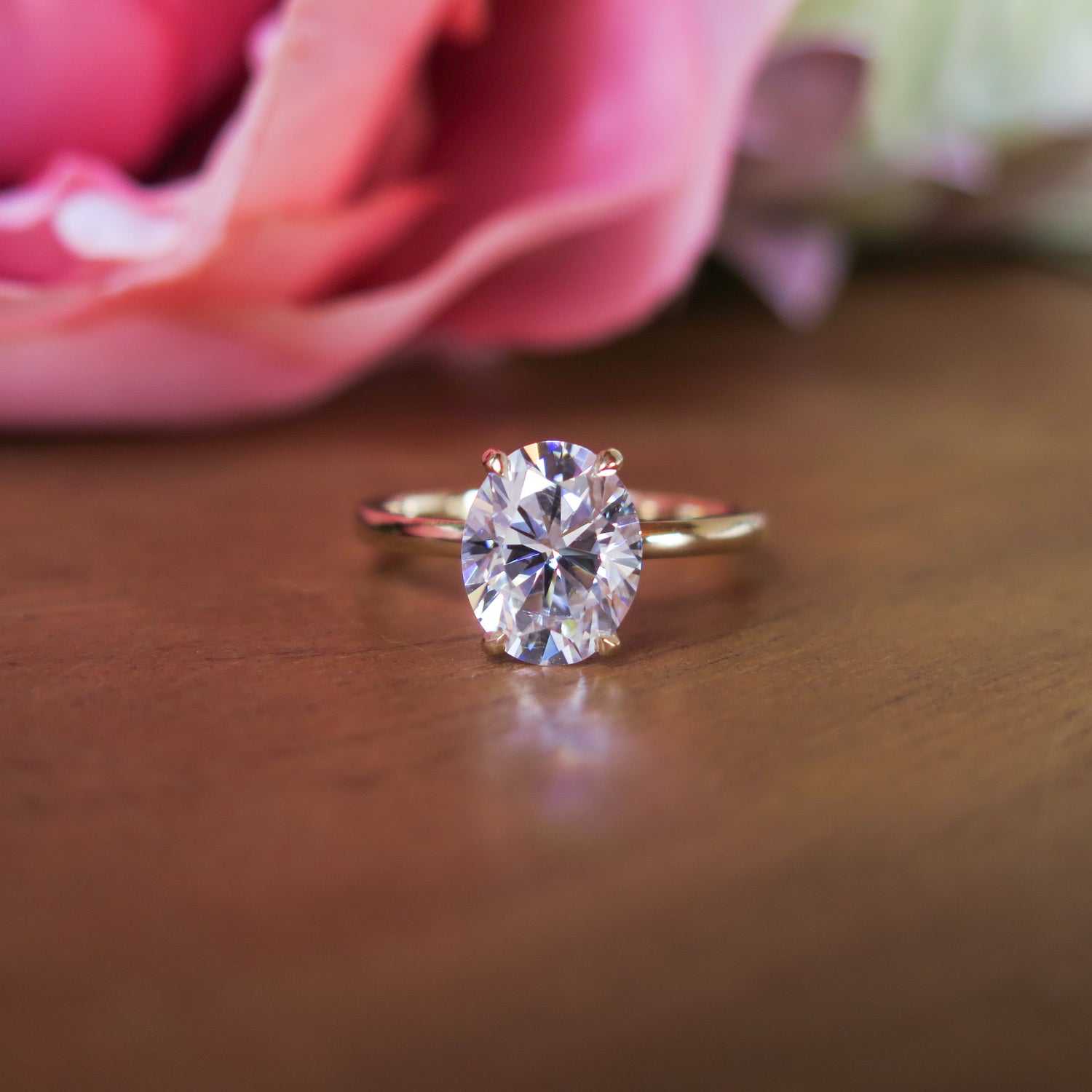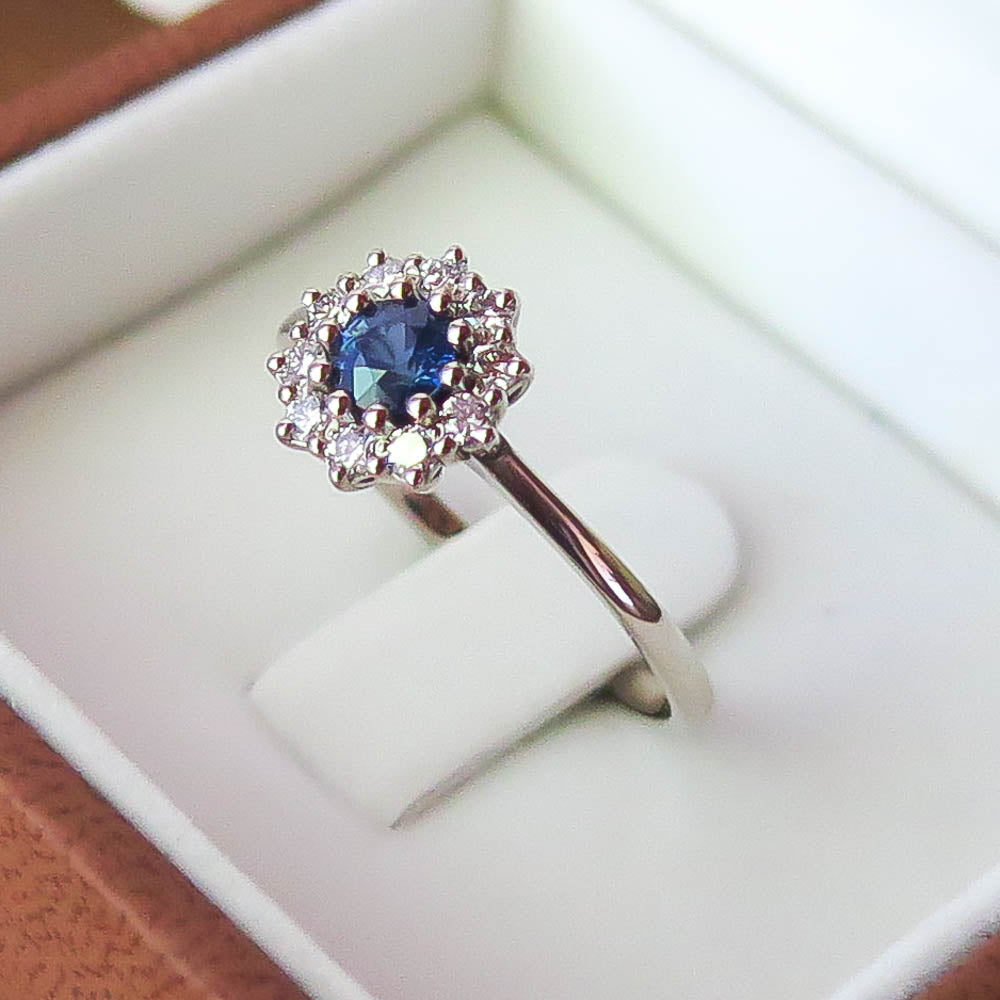Zircon
Not to be confused with cubic zirconia, zircon is a completely natural gem in its own right, with its own special characteristics.

Species: Zircon
Notable Associations: Zircon is the traditional December birthstone, as well as the 4th (blue) and 11th (yellow – also known as hyacinth) wedding anniversary stone.
Chemical composition: zirconium silicate
Known colours: Colourless, yellow, brown, orange, red, violet, blue, green.
Mohs Hardness: 6.5 – 7.5
Zircon is double refractive, and so each facet edge will appear to be duplicated, creating the illusion that the photographs are out of focus.
Deposits found in: Burma, Cambodia, Sri Lanka, Thailand, France, Australia, Brazil, Korea, Madagascar, Mozambique, Nigeria, Tanzania, Vietnam.
Zircon is a natural mineral and most probably takes its name from the Persian word zargun, which means 'golden coloured'. The colour variety most likely responsible for that description, has historically been referred to as hyacinth (which also includes orange or reddish brown varieties), and is mentioned in several ancient texts, including the Old Testament of the Bible. When cut, zircon exhibits exceptional brilliance and a diamond-like fire and luster. Well cut colourless specimens closely resemble diamond.
Zircon is the perfect stone for low-light environments like evening functions and comes alive in warm lighting.
Zircon is available in most colours of the spectrum, though the majority of the material on the market today is heat treated to achieve a sky blue colour.
VARIETIES OF ZIRCON:
Blue Zircon: This variety displays the same sky blue as most commercial blue topaz, but with more fire and brilliance. Blue zircon is sensitive to scrapes and knocks so care should be taken when setting them in rings. It is usually cut quite deep in order to produce as much brilliance as possible.

Green Zircon: Mostly mined in Sri Lanka, this variety can also be grayish or yellowish.

Hyacinth: This variety includes all yellow-orange and orange-brown specimens. The colour is usually improved by heat treatment.

Synthetic zircon can be produced, but is only of scientific interest and the process is not commercially viable.

Are you thinking of getting engaged soon?
Book a free consultation (in person or via Zoom) and let me help you bring your idea to life. Free nationwide door-to-door shipping is included on all orders over R1500.

Frequently Asked Questions
How does it work? Where do I start?
The best place to start is with the gemstone that will be the central feature of the ring because this dictates many of the other proportions of the piece. For a detailed breakdown of the process, click here.
Can I bring my own diamond or other gemstones?
Yes, you are more than welcome to do that. Many people inherit a stone from a family member or would like to reuse a stone they bought on another occasion. That is perfectly fine with me.
What metals do you work in?
I work in all precious metals commonly used for jewellery, so that would be sterling silver, argentium silver, yellow gold and white gold (9K, 14K, 18K), and platinum. For more information on precious metals and the difference between them, click here.
What is the difference between white gold and platinum?
Platinum is an element on the periodic table, a metal in its own right, while white gold is an alloy of pure yellow gold and other metals. Here is a bit of history:
In the late 19th century bench jewellery was revolutionised by the invention of the
pressurised oxygen tank, or liquid oxygen, which for the first time became
commercially available at affordable prices. This led to the development of the
oxyacetylene mixing torch, invented in France by Edmond Fouché and Charles
Picard, and for the first time made possible a flame that could reach the
temperatures required for solid platinum (Pt) jewellery manufacturing.
Platinum quickly emerged as the new darling in the world of fine jewellery, with its
brilliant white colour it complimented white diamonds, which thanks to De Beers
were having a moment at the same time too, and its fantastic tensile strength
made extremely delicate designs possible for the first time in history.
With the end of the Edwardian era and the start of WWI, platinum all but disappeared in
jewellery, due to its usefulness as a catalyst in explosive devices but
experienced a brief period of resurging glory (the Art Deco period) between the
great wars, mostly thanks to the discovery of the Merensky Reef, a platinum
deposit which stretches from northern Gauteng into Mpumalanga and Limpopo.
During WWII the US government declared platinum a metal of strategic importance, and almost
completely banned its use in anything outside of military applications. This
led to the development of a new gold alloy we know today as white gold.
White gold is a mixture of pure yellow gold and other metals such as silver, copper and
zinc, which are common in other gold alloys, but with the addition of palladium
or nickel to bleach out the yellow colour. Because its base is still yellow
metal, it isn’t quite white and is usually plated with another, whiter metal to
create the crisp white finish consumers expect. This used to be done with
rhodium (Rh), but after that metal’s price skyrocketed in recent years, it has
been replaced by other metals.
Nickel alloys have almost completely fallen out of use because most people are
allergic to them. It perseveres in mass production white gold jewellery though,
so be sure to ask before you make a purchase. My preferred alloy contains 10%
palladium. Although the palladium content makes it quite a bit more expensive
than the nickel alloys, it has good tensile strength, is unlikely to cause
allergic reactions, and has a white enough finish for it to still appear white
even without the plating.
Because it contains gold (Au), white gold alloy fineness (purity) is expressed the same
way as yellow gold, in karatage (9K, 14K, 18K) or parts in 1000 (375, 585, 750). In South Africa platinum jewellery is usually 95% pure Pt, with a 5%
copper or ruthenium alloy.
You can read more about the composition of white gold here.
Can I buy a diamond from you?
Yes, I source quality diamonds based on your requirements. During your consultation we can discuss the pros and cons of both natural and laboratory-grown diamonds. I usually call a few options for you to view before making your decision. I do not keep diamonds on the premises for security reasons, so you will need to book this viewing in advance. For more information on how to choose a natural diamond, click here. For more information on laboratory-grown diamonds, click here.
What if I don't want a diamond?
I get you. There are plenty of other options. Moissanite is increasingly popular as a replacement for diamond, and lots of people are opting for coloured gemstones instead. I can source whatever you need. Click here to browse a selection of coloured gemstones I offer on behalf of a third party seller. Like with diamonds you will need to book viewings in advance because I need time to request the stone from the supplier.
What is moissanite?
Moissanite is a man-made gem which has very similar properties to diamond, although not quite as hard. Click here to read more about this affordable alternative.
What other services do you offer?
Other services include remodeling of old jewellery and insurance valuations. For a list of my services, click here.
Can I see some of the things you have made?
My social media accounts are really the best place to see this, but I have a small gallery on the website which you can find here.
